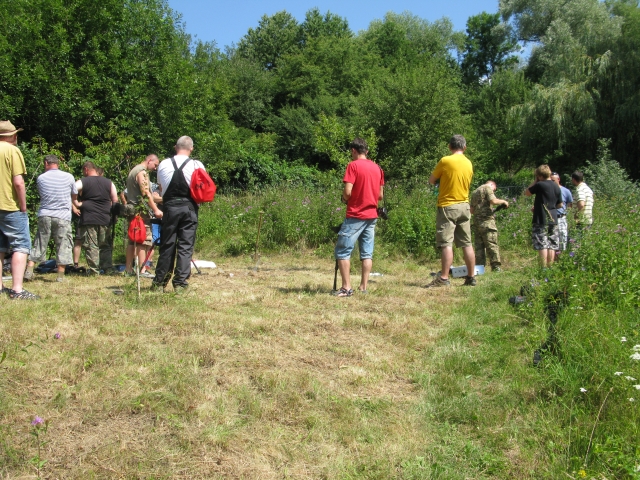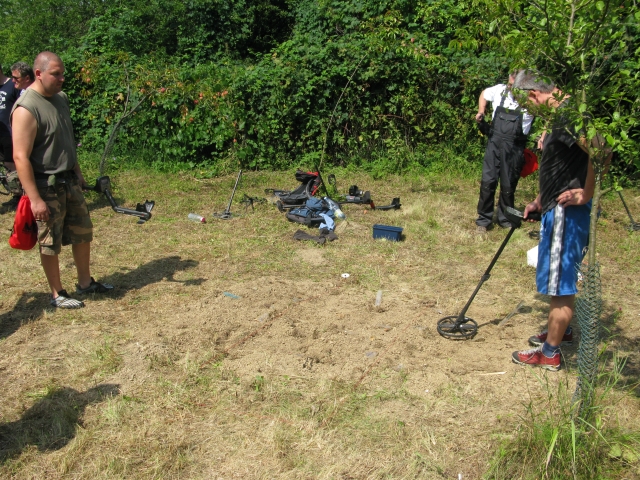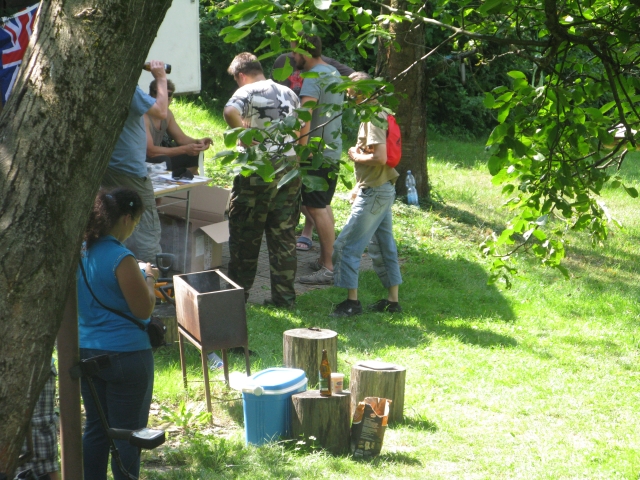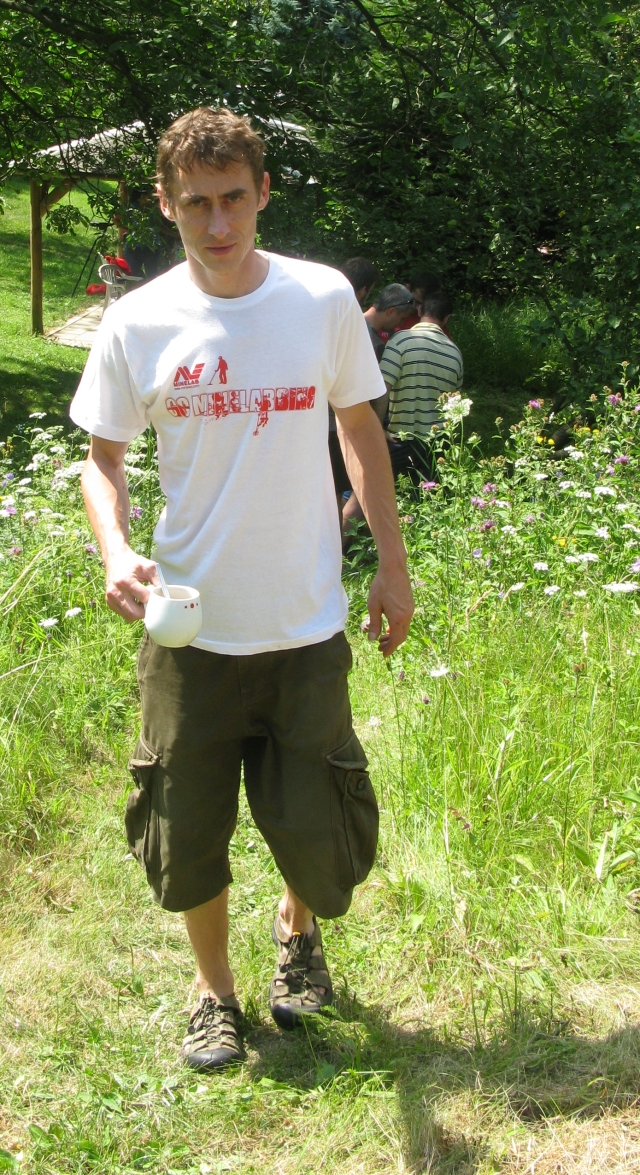koukám počásko vyšlo
How was Moravia Minelab Day
Categories: Minelab – tests and reviews , Treasure Hunters and Archeo Treasure Hunters 2010 events
The weather for the Moravian Minelab day was really good. The sun was blazing from the morning and the sky was literally swept clean. We were also surprised at the turnout for being a holiday and all the polygons were pretty full. But the event was really successful and not only did many probes get tested, but also a lot of setups.
Originally I wanted to make some clear tables of ranges of what went well and how. However, during the alce it turned out that it was definitely not going to be that simple, as if you have say 5 Etracs on a polygon and all the owners walk a bit differently, you might get slightly different results too![]() . So I will always try to list the detector, the results we got and the setup that seemed to work best. All tests were done on a tube polygon that was drilled so the ground above the tube was completely compact. In addition, the local soil is enriched with the mineral andesite, which does not do well for the detectors. Many instruments have trouble tuning the soil at all, but this is not the case with the Minelab detectors. Yet, especially with the simpler VFLEX detectors like the X-Terra series, such problematic soil will affect the range.
. So I will always try to list the detector, the results we got and the setup that seemed to work best. All tests were done on a tube polygon that was drilled so the ground above the tube was completely compact. In addition, the local soil is enriched with the mineral andesite, which does not do well for the detectors. Many instruments have trouble tuning the soil at all, but this is not the case with the Minelab detectors. Yet, especially with the simpler VFLEX detectors like the X-Terra series, such problematic soil will affect the range.
X-Terra series
The models tested were mainly X-Terra 705 so we'll stick with this model in the description. As a reference target telling for all is in this case 1 CZK. Several 705's were run on the polygon in different setups, all with a 26 cm 2D 7 kHz baseline probe. The measured values ranged from 21 to 25 cm. The best settings were:
- Discrimination: up to a maximum of -3
- Sensitivity: as far as conditions allow, here it was about 24
- Manually detune the ground
- Threshold: slightly audible
Of the range of additional probes tested, the best setup was Nel Storm at 18.75 kHz. With the same settings, the range per 1 Kčs was 5 to 7 cm better depending on the detector setting, which was a very good increase indeed. The other probes did not lose out either, and in the imaginary second place in terms of depth, we must name the probe Coiltek WOT 15at 18.75 kHz. The best probe in terms of range/separation ratio was probably the Nel Nunter at 18.75 kHz. The probe managed to add a little bit of range and still had better separation properties. Moreover, the range on the smallest gold target weighing 0.3g was almost identical to the top models with the basic probe. The
X-Terry certainly did not disappoint and only proves that in the mid-range class of purely digital detectors it is hard to find competition.
E-Trac
E-Tracy were along with the CTX 3030 certainly the most tested instrument. Here too, the biggest differences in setup and consequently in the results obtained could be seen. The reference test target in this case was the Prague groschen. The results obtained with the 11" basic probe were from about 30 cm to 35 cm. In our recommended setting it was 35 cm. The most common error was the use of the Coins discriminating mode, which is factory and not suitable for our environment and you may well lose many targets. The discrimination in this mode is just too great.
Below are thesettings that gave the best results:
Discrimination: fill the right corner and/or the strip at the bottom of the LCD to the level of the number 30
Sensitivity settings: wherever possible, here the setting was 23 to 25 with almost no differences in detector behavior
Audio: threshold max 20,Volume limit 30, Volume gain, Response Long, Tone ID Conduct, Number of tones Multitone. It should be added that all tests were done on a speaker. Therefore, if headphones are used, the volume, threshold and amplifier levels need to be reduced.
Expert: Deep on, Fast On, Trash - depending on conditions, ground neutral.
Then other additional probes started to be tested. The deepest one went Detech SEF 18x15which got to 40+. The pipe was not drilled deeper so we don't know where else to go. But at 40, the signal was still more than decent. It also went very well Nel Atackthat still had a faint sound at the end of the range and we wrote it down as 40. Detech Ultimatewhich is often used by searchers, reached 38-39 cm with a kickable signal.
Those who know this detector know what it can do. Although it is often written about some difficult setup, it is actually only 5 or 6 items. A number of searchers have been surprised at what can be squeezed out of their detector with even a simple change of settings.![]()
CTX 3030
Given that CTX 3030 Olda, Pavel, Simon and I have been coming, the most time has been spent on the different settings. So all probes and several types of targets were tested. The reference coin here was 1 CZK. The detector with the basic probe handled it safely at 35 cm. Even with a more conservative setting with more discrimination, the range was 32-33 cm. In addition, the CTX enjoyed a much higher sensitivity setting without starting to make any telltale noises. I myself had the detector set at 28, but a number of guys had 30 on there since they are used to just walking around like that.
The recommendedsetting wearrived at:
Discrimination: right horn, just close the unambiguous irons, or make a line along the bottom edge of the LCD. Of course, it is also possible to walk completely without discrimination in Ferrous mode.
Sensitivity:26 and above. I would always choose manual mode. Automatic will pick up about 10% of the range
Tone ID - 50 CO or with zero discrimination 4 FE
Response: Long
Deep:On
Fast:On (if there is a minimum number of targets in the area, turn the function off, the detector will slightly refine the evaluation)
Ground tuning: quiet automatic,works extremely accurately.
Searing mode: GroundCoin or Ferrous Coin
The great advantage of the CTX 3030 is its stability, from which comes the possibility of higher sensitivity settings. Also very convincing is the detector's response to coins set differently on edge. At this point I dare say that regardless of brands and prices, the CTX has no competition on the market at the moment.
Since the first additional probes from Coiltek will not arrive until the beginning of next month, only two probes were available for testing, large 17" a small 6" weaving. The large probe went about 4 to 6 cm deeper at the 1 Centimetre range. That's an increase of more than 10%. The small probe for extreme separation saw 1 Kcms at about 19-20 cm depending on the settings used, which is more than adequate range given its size and the purpose for which it was developed!
SDC 2300
The event also saw the introduction of SDC 2300. With the setup at number 2 we tested the finest targets available. The detector saw everything without a problem. Then it was on to the larger range tests where the SDC was first tested in the recommended setting on the finest gold and the results of the detector set up in this way were roughly the range of the X-Terry 705. Then it was on to the tests in, say, the depth setting at number 5. So that was a bit of a different ride and the detector, for example, on a slope polygon, picked up a beer can at 65 cm with no problem.
But probably the most impressive was actually the demonstration at the very beginning. Although the polygon site had been carefully cleaned and none of the detectors used had any targets in the vicinity pipe, immediately after we started the SDC demonstration in the morning I could clearly hear the target almost above the test pipe. A little confused at first we thought maybe it was some kind of interference, after all there were about 40 detectors around that someone kept turning on and off, not to mention all the cell phones and tablets. So we tried detector re-tuning and ...... target was still there. Finally, we cautiously started digging. Turns out it was a small pinprick with a dart...... well just power.
The SDC 2300 is a really rewarding detector to operate as there is basically nothing to go wrong. You turn the detector on and set it to either Sole (that's when you walk the beach), or to 2jk if you're looking for small gems, or to 5jk if you're looking to track deeply buried targets. Nothing more is needed ![]() .
.
Conclusion
It was a beautiful day at Olda's cottage. In the afternoon we were there for a little while to roll around in the sun, but then it was off home. Olda, Pavel and Simon transported the event perfectly and I am looking forward to the next autumn continuation. The results of the separation polygon should be processed by Olda and Pavel, as I was there myself basically just to walk around and Simon and I spent almost the whole morning just on my pipe.![]()
Elmara
Link to the event organizer: Moravia Detect - the largest selection of detectors in Moravia
Contact: Mgr. Oldrich Habrovanský Tel: 774 980 808











The article is included in categories:
- Archive of articles > Metal Detectors - Reviews and Tests > Minelab – tests and reviews
- Archive of articles > Archaeology > Treasure Hunters and Archeo Treasure Hunters 2010 events
Post
Jo jo, lepší než v ZOO v květnu. Asi to bylo tím, že nám tam chyběly ty manekýny  Tacud
Tacud
Dobrá práce, dobrý postřehy!
Jen bych doplnil jednu chybnou interpretaci v textu, na přípravě akce se samozřejmě plně podílel i Šimon 
Opraveno  , mě to normálně nedošlo, Šimon se mnou dělal celou dobu ten hloubkový polygon, že mi nakonec přišlo, že přijel se mnou
, mě to normálně nedošlo, Šimon se mnou dělal celou dobu ten hloubkový polygon, že mi nakonec přišlo, že přijel se mnou 
By mě zajímalo kam bys ho v tom narvanym autě vedle předsedy dal  Ale zase by se Pilot válel po něm a ne po mojí mikině
Ale zase by se Pilot válel po něm a ne po mojí mikině 
pěkný počteníčko a gratulka za slušnou akcičku nadšenců uznávajících jen Minelab.
tak ať vám to PÍPÁ.
já zůstávám věrný detíkům White´s 
Předseda by se měl alespoň ke komu tulit a nebyl by vzadu tak sám  Koukal jsi na býčky?
Koukal jsi na býčky? 
Diskriminace: maximálně do čísla -3 ? 705 má škálu diskriminace po dvou, nebylo to myšlenu v prospecting modu?
Lucky: prostě si poslední kostičku se zápornými čísli už nezavírej 

Aha..chlapci na moravě a já v čechách...

















